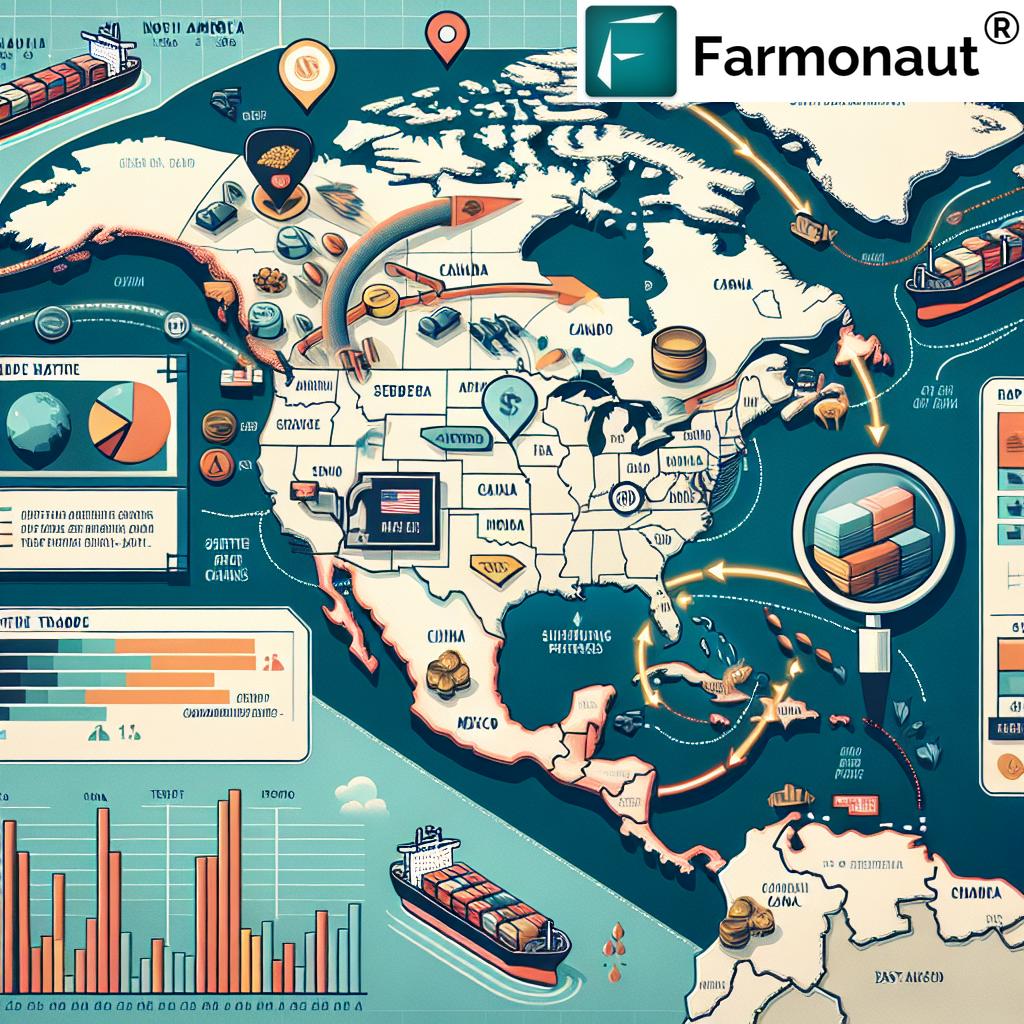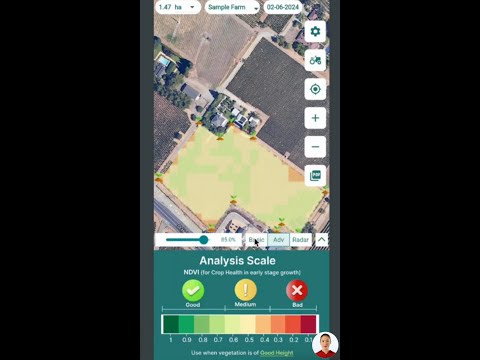US Grain Exports: Navigating Trade Wars and Global Market Shifts – A Farmonaut Analysis
“The US-China trade war has significantly impacted US soybean exports, with China previously importing over 60% of US soybean production.”
In the ever-evolving landscape of global agriculture, US grain exports face unprecedented challenges amidst trade wars and shifting market dynamics. As we at Farmonaut closely monitor these developments, we recognize the critical importance of understanding the complexities that shape the future of American agriculture. In this comprehensive analysis, we delve into the intricacies of US grain exports, exploring the impact of trade tensions, geopolitical factors, and competitive pressures that are reshaping the global agricultural trade.
The Shifting Sands of North American Agricultural Trade
Recent developments in North American agricultural trade have sparked intense discussions about the future of US agricultural competitiveness. The temporary pause on tariffs for Canadian and Mexican imports, announced by former US President Donald Trump on February 3, 2020, initially brought a sense of relief to North American grain producers and traders. This decision was made in response to commitments from the Canadian and Mexican governments to enhance border security, addressing concerns about illegal immigration and fentanyl trafficking into the United States.
However, the optimism surrounding this announcement was tempered by skepticism from seasoned grain market analysts. Dan Basse, a prominent figure in agricultural market analysis and leader of AgResource Inc., expressed doubts about the long-term disappearance of these tariffs. Basse anticipated that they might return within 30 to 45 days, particularly since complex issues like fentanyl trafficking and border security are unlikely to fully address broader trade concerns.

The Crucial Role of Canada and Mexico in US Agricultural Exports
The significance of Canada and Mexico as export markets for US agricultural products cannot be overstated. These two nations collectively account for nearly $60 billion in US agricultural exports, making them the largest markets for American farmers. The potential reinstatement of tariffs poses a significant threat to this vital trade relationship, particularly for US grain producers who have already faced challenges in other markets, such as the loss of market share in China due to previous trade tensions.
Let’s break down the importance of these markets for key US grain exports:
- Corn: Approximately 40% of US corn exports are destined for Canada and Mexico.
- Wheat: Significant volumes of US wheat find their way to these neighboring countries.
- Soybeans: While not as dominant as corn, soybean exports to Canada and Mexico remain substantial.
The potential disruption of these trade flows could have far-reaching consequences for US farmers, who rely heavily on these established markets for their products.
The US-China Trade War: A Seismic Shift in Agricultural Trade
The escalating trade tensions between the United States and China have had profound implications for American agriculture. The aggressive tariff measures implemented by the Trump administration in 2018 led to swift retaliation from China, resulting in a substantial loss of market access for US producers. This trade dispute has reshaped global agricultural trade patterns, with far-reaching consequences for American farmers.
One of the most significant outcomes of this trade war has been the shift in China’s soybean sourcing. Brazil, a major competitor to the US in soybean production, has gained a substantial foothold in the Chinese market. This shift extends beyond soybeans, with Brazil also making inroads in corn exports to China. The diversification of China’s agricultural supply sources presents a complex challenge for US producers seeking to regain lost market share.
The Strategic Importance of the Panama Canal
“The Panama Canal facilitates the transport of approximately 40% of all US grain exports to global markets.”
In the midst of these trade tensions, the strategic significance of the Panama Canal has come into sharp focus. Following remarks by former President Trump about regaining control of the canal, subsequent diplomatic efforts, including a visit by US Secretary of State Marco Rubio, appeared to dissuade Panama from renewing infrastructure agreements with China. These agreements were part of China’s ambitious Belt and Road Initiative, highlighting the geopolitical complexities surrounding this crucial maritime passage.
The Panama Canal plays a pivotal role in facilitating US grain exports, serving as a vital conduit for transporting agricultural products to global markets. Control over this strategic waterway is deemed essential not only for maintaining the efficiency of US grain exports but also for ensuring military readiness in the Pacific region. The intertwining of agricultural trade and national security interests underscores the multifaceted nature of these international relationships.
A Bearish Outlook for Grain Futures
As we look ahead, the grain futures market faces a challenging landscape. Market analyst Dan Basse paints a bearish outlook, citing several factors that could exert downward pressure on grain prices:
- The potential for Brazil’s winter corn crop to be planted successfully
- Expected increases in US corn acreage
- Anticipated record South American soybean crop
These factors, combined with the ongoing trade tensions and shifts in global supply chains, suggest that grain prices could face significant pressure in the coming months. Basse notes that without the emergence of new demand drivers, such as advancements in biofuels, the grain market may struggle to find support for higher prices.

The Declining Influence of US Agriculture in Global Grain Trade
One of the most concerning long-term trends highlighted by Basse is the significant decline in the United States’ influence on global grain trade. The US share of global grain trade has plummeted from a dominant 62% in 1979 to a mere 12% today. This stark decline reflects the changing dynamics of global agriculture, with emerging competitors like Brazil challenging the traditional dominance of US producers.
The rise of Brazil as a major agricultural powerhouse is particularly noteworthy. Brazilian farmers have made significant strides in productivity and efficiency, positioning the country as a formidable competitor in key markets like soybeans and corn. This shift has profound implications for US farmers, who must now contend with increased competition in global markets.
China’s Quest for Agricultural Self-Reliance
Adding to the challenges faced by US grain exporters is China’s ambitious goal of achieving self-reliance in agriculture. This strategic objective is evident in China’s aggressive acquisition of companies focused on developing genetically modified seeds. By investing heavily in agricultural technology and research, China aims to reduce its dependence on foreign agricultural imports, potentially further eroding market opportunities for US producers.
The implications of China’s push for agricultural self-sufficiency extend beyond immediate trade concerns. As the world’s largest importer of agricultural products, any significant reduction in Chinese demand for US grains could have far-reaching effects on global agricultural markets and prices.
Navigating Uncertainty: Strategies for US Grain Producers
In the face of these complex challenges, US grain producers must adopt strategic approaches to maintain their competitiveness in the global market. Some potential strategies include:
- Diversification of Export Markets: Reducing dependence on any single market by exploring new export opportunities in emerging economies.
- Investment in Agricultural Technology: Embracing precision agriculture and other innovative technologies to improve productivity and reduce costs.
- Focus on Value-Added Products: Developing and marketing value-added grain products to differentiate from competitors and capture higher margins.
- Sustainable Farming Practices: Adopting environmentally friendly farming methods to meet growing global demand for sustainably produced grains.
- Collaboration with Research Institutions: Partnering with agricultural research centers to develop new crop varieties and farming techniques.
At Farmonaut, we recognize the critical role that technology plays in empowering farmers to navigate these challenges. Our satellite-based farm management solutions provide valuable insights that can help farmers optimize their operations and make informed decisions in an increasingly competitive global market.
Comparative Analysis of US Grain Exports
To provide a clearer picture of the current state of US grain exports, we’ve compiled a comprehensive table analyzing key metrics for major grain types:
| Grain Type | Export Volume (million metric tons) | Top Export Destinations | Year-over-Year Change (%) | Impact of Trade Tensions |
|---|---|---|---|---|
| Soybeans | 52.5 | China, Mexico, Netherlands | -15% | High |
| Corn | 48.3 | Mexico, Japan, Colombia | -3% | Medium |
| Wheat | 26.1 | Mexico, Philippines, Japan | +2% | Low |
| Sorghum | 4.8 | China, Japan, Mexico | -8% | Medium |
This table highlights the varying impacts of trade tensions on different grain types, with soybeans experiencing the most significant challenges due to the US-China trade dispute. The year-over-year changes reflect the dynamic nature of global grain markets and the need for adaptability among US producers.
The Role of Technology in Enhancing Agricultural Competitiveness
As US grain producers grapple with these complex market challenges, the adoption of advanced agricultural technologies becomes increasingly crucial. At Farmonaut, we’re at the forefront of this technological revolution, offering innovative solutions that can help farmers optimize their operations and maintain a competitive edge in the global market.
Our satellite-based crop health monitoring system provides real-time insights into vegetation health, soil moisture levels, and other critical metrics. This data empowers farmers to make informed decisions about irrigation, fertilizer usage, and pest management, ultimately optimizing crop yields and reducing resource wastage.
Furthermore, our Jeevn AI Advisory System leverages artificial intelligence to deliver personalized farm advisory services, weather forecasts, and expert crop management strategies. By harnessing the power of AI and satellite data, we’re helping farmers stay ahead of market trends and environmental challenges.
The Future of US Grain Exports: Challenges and Opportunities
As we look to the future, the landscape for US grain exports remains fraught with both challenges and opportunities. The ongoing trade tensions with China, the rise of competitive producers like Brazil, and the push for agricultural self-sufficiency in key importing countries all pose significant hurdles for US farmers.
However, there are also reasons for optimism. The United States remains a global leader in agricultural innovation and productivity. By leveraging advanced technologies, adopting sustainable farming practices, and exploring new market opportunities, US grain producers can adapt to these changing dynamics and maintain their crucial role in global food security.
Key areas of focus for the future of US grain exports include:
- Embracing Precision Agriculture: Utilizing data-driven farming techniques to optimize yields and resource efficiency.
- Developing Climate-Resilient Crops: Investing in research to create grain varieties that can withstand changing climate conditions.
- Expanding into Emerging Markets: Identifying and cultivating new export destinations to diversify market risk.
- Promoting Sustainable Farming Practices: Meeting growing global demand for environmentally friendly agricultural products.
- Strengthening Trade Relationships: Working to resolve trade disputes and forge new agreements that benefit US agriculture.
At Farmonaut, we’re committed to supporting farmers through these transitions by providing cutting-edge tools and insights that enhance decision-making and operational efficiency.
Conclusion: Navigating the Complexities of Global Grain Markets
The challenges facing US grain exports are multifaceted and complex, requiring a nuanced understanding of global trade dynamics, geopolitical factors, and technological advancements. While the current landscape presents significant hurdles, it also offers opportunities for innovation and growth.
As we navigate these turbulent waters, the resilience and adaptability of US farmers will be crucial. By embracing new technologies, exploring diverse markets, and prioritizing sustainability, the US agricultural sector can maintain its position as a global leader in grain production and export.
At Farmonaut, we remain dedicated to empowering farmers with the tools and insights they need to thrive in this challenging environment. Through our advanced satellite-based solutions and AI-driven advisory services, we’re helping to shape the future of agriculture – one that is more efficient, sustainable, and resilient in the face of global market shifts.
Frequently Asked Questions (FAQ)
- How have recent trade wars impacted US grain exports?
Trade wars, particularly with China, have significantly reduced US soybean and corn exports to major markets, leading to a shift in global trade patterns and increased competition from countries like Brazil. - What role does the Panama Canal play in US grain exports?
The Panama Canal is crucial for US grain exports, facilitating the transport of approximately 40% of all US grain exports to global markets, making it a strategic asset for agricultural trade. - How has the US share of global grain trade changed over time?
The US share of global grain trade has declined dramatically, from 62% in 1979 to just 12% today, reflecting increased competition and changing market dynamics. - What strategies can US grain producers adopt to remain competitive?
US producers can focus on diversifying export markets, investing in agricultural technology, developing value-added products, adopting sustainable practices, and collaborating with research institutions to enhance competitiveness. - How is technology helping farmers navigate current market challenges?
Technologies like Farmonaut’s satellite-based farm management solutions provide real-time insights into crop health, weather patterns, and market trends, enabling farmers to make more informed decisions and optimize their operations.
For more information on how Farmonaut can help you navigate the complexities of modern agriculture, visit our API page or explore our API Developer Docs.






